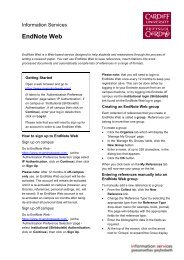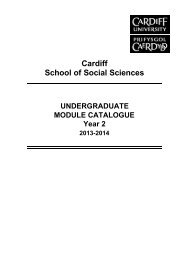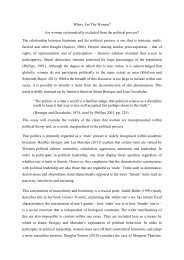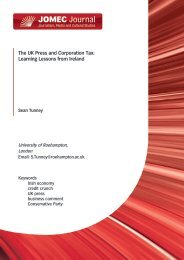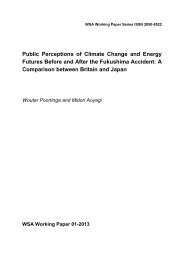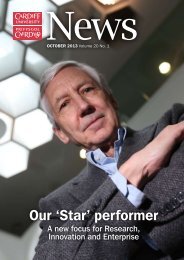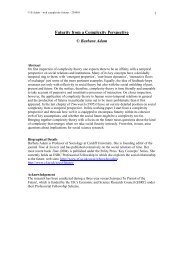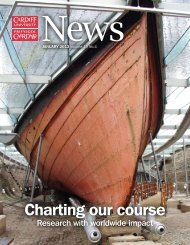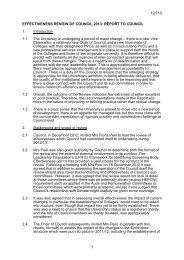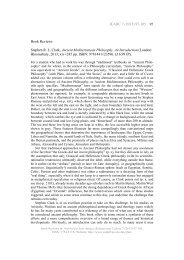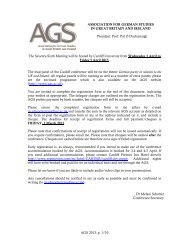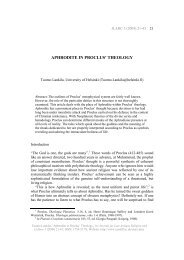Tina Askanius - Cardiff University
Tina Askanius - Cardiff University
Tina Askanius - Cardiff University
Create successful ePaper yourself
Turn your PDF publications into a flip-book with our unique Google optimized e-Paper software.
Textual analysis and attention to<br />
media form<br />
This study argues for the importance of<br />
close attention to the long history of so<br />
called new media. However, the primary<br />
aim of this article is not to provide a<br />
history of video activism but rather to<br />
examine video texts and their extratextual<br />
circumstances in relation to their<br />
historical contexts. In this manner, the<br />
study is positioned within a tradition of<br />
media studies that gives prevalence to<br />
the analysis of media form and considers<br />
this an important entry point into<br />
understanding the social and political<br />
order of media. Such a tradition is<br />
concerned with issues of power and<br />
commits to the close micro-analysis of<br />
the languages and images of media texts<br />
located within the broader contexts of<br />
social practice and public conduct<br />
(Corner 1995). This analytical strategy<br />
poses questions of the ways in which<br />
prevalent forms of audio-visual<br />
mediation ‘offer ethical positions for<br />
viewers to occupy providing possibilities<br />
for enhanced critical awareness and<br />
favourable conditions for social action’<br />
and provides insights into ‘the virtues of<br />
media representations that may cultivate<br />
(or impinge on) reflexive and active<br />
publics’ (Chouliaraki 2006: 5). I draw on<br />
the work of Corner (2008, 2011) to<br />
establish an understanding of media<br />
form in terms of three overlapping<br />
dynamics: organisation, articulation, and<br />
apprehension. This understanding of<br />
form, carried into the textual analysis of<br />
videos in the YouTube environment has<br />
implications for how attention is focused<br />
on different dimensions of the videos<br />
and the platform in which they<br />
proliferate. It becomes possible to extend<br />
the scope of the analysis beyond<br />
questions of what is depicted on screen<br />
so as also to induce analytical<br />
susceptibility in the various dynamics of<br />
viewers’ engagement with the videos. In<br />
this manner, considering form as a<br />
three-dimensional concept reflects the<br />
various (often overlapping) ways of<br />
approaching the object of analysis as<br />
both video texts (their aesthetic qualities<br />
and protocols of argument) and their<br />
extra-textual circumstances (how they<br />
are presented online, shared, liked,<br />
‘favorited’, commented upon etc.).<br />
Contextualising radical filmmaking: the<br />
historical roots of online video<br />
activism<br />
Online video activism should be<br />
understood in relation to a long history<br />
of political practices and traditions of<br />
scholarly attention towards these<br />
practices. The prefixes ‘alternative’,<br />
‘radical’, ‘progressive’ etc. variously put in<br />
front of ‘video’ to designate largely Leftleaning<br />
filmmaking signal a commitment<br />
to political action and social change. As<br />
a rebuttal to dominant mainstream<br />
(mis)representations of political protests<br />
and movements, video activism is<br />
defined by a commitment to explain<br />
‘what people are protesting’ in ways that<br />
project an alternative image, especially of<br />
non-violent disobedience, and in doing<br />
so draw on a critical, political and<br />
aesthetic vocabulary largely absent in<br />
dominant culture (Juhasz 1995: 32).<br />
Juhasz (1995) argues that significant<br />
productions of political filmmaking occur<br />
when rapid changes in politics, theory<br />
and technology align. Historically,<br />
politically committed video can thus be<br />
traced through a number of film and<br />
video movements rooted in the political<br />
struggle for representation and voice. In<br />
a Western context, the American<br />
underground cinema of the 1950s and<br />
early 1960s can be seen as a direct<br />
precursor to the radical protest cinema<br />
3 <br />
www.cf.ac.uk/JOMECjournal<br />
@JOMECjournal



